

Research Goals
Our group's research goal is to enable the design and fabrication of advanced flexible structures, mechanisms, and materials that achieve extraordinary capabilities via the deformation of their constituent compliant elements. Such systems are inherently repeatable, scalable, human-safe, low-cost, easy to maintain, adaptable, lightweight, able to store strain energy or accommodate imperfections, and are versatile in the kinematics they are able to achieve. Despite the importance of flexible systems, designing them can be overly burdensome due to the complex nonlinear mechanics that govern their behavior. Moreover, fabricating flexible systems can be difficult or impossible if their geometry is complex, irregularly shaped, submicron-sized, and/or possesses an unmanageably large number of constituent compliant elements. Our group aims to generate the knowledge necessary to overcome these obstacles for enabling the creation of new and disruptive compliant technologies. Areas of particular interest to our group include: Architected Materials (a.k.a., mechanical metamaterials), Additive Fabrication for enabling such materials, flexure-based Microelectromechanical Systems (MEMS), Precision Flexure Systems, Soft Robots, and compliant Medical Devices. Click on any of the highlighted words to learn more.
Actively Controlled Architected Materials with Programmable Mechanical Properties
The aim of this research is to enable the design and fabrication of active architected materials that consist of large periodic lattices of independently controlled unit cells, which can be programmed to interact in such a way as to allow the overall lattice to achieve desired combinations of actively tunable bulk mechanical properties (e.g., Young’s modulus, shear modulus, Poisson’s ratio, and other damping properties). The unit cells within such active architected materials behave as self-contained mechatronic systems that each consist of the necessary actuators, sensors, flexure bearings, and control circuitry for achieving the desired bulk mechanical properties using principles of swarm control. Click here to learn more.
An actively controlled design that utilizes piezo actuators to achieve programmable and uploadable mechanical properties.
An actively controlled design that utilizes comb-drive actuators to achieve programmable and uploadable bulk shapes.
Compliant Rolling-contact Architected Materials
The aim of this research is to enable the design and fabrication of a new kind of metamaterial that utilizes flexure straps to guide the rolling motions of rigid cams to achieve extreme shape morphing capabilities. These materials can deform over large ranges without appreciably increasing in strain energy or internal stress. Click here to learn more.
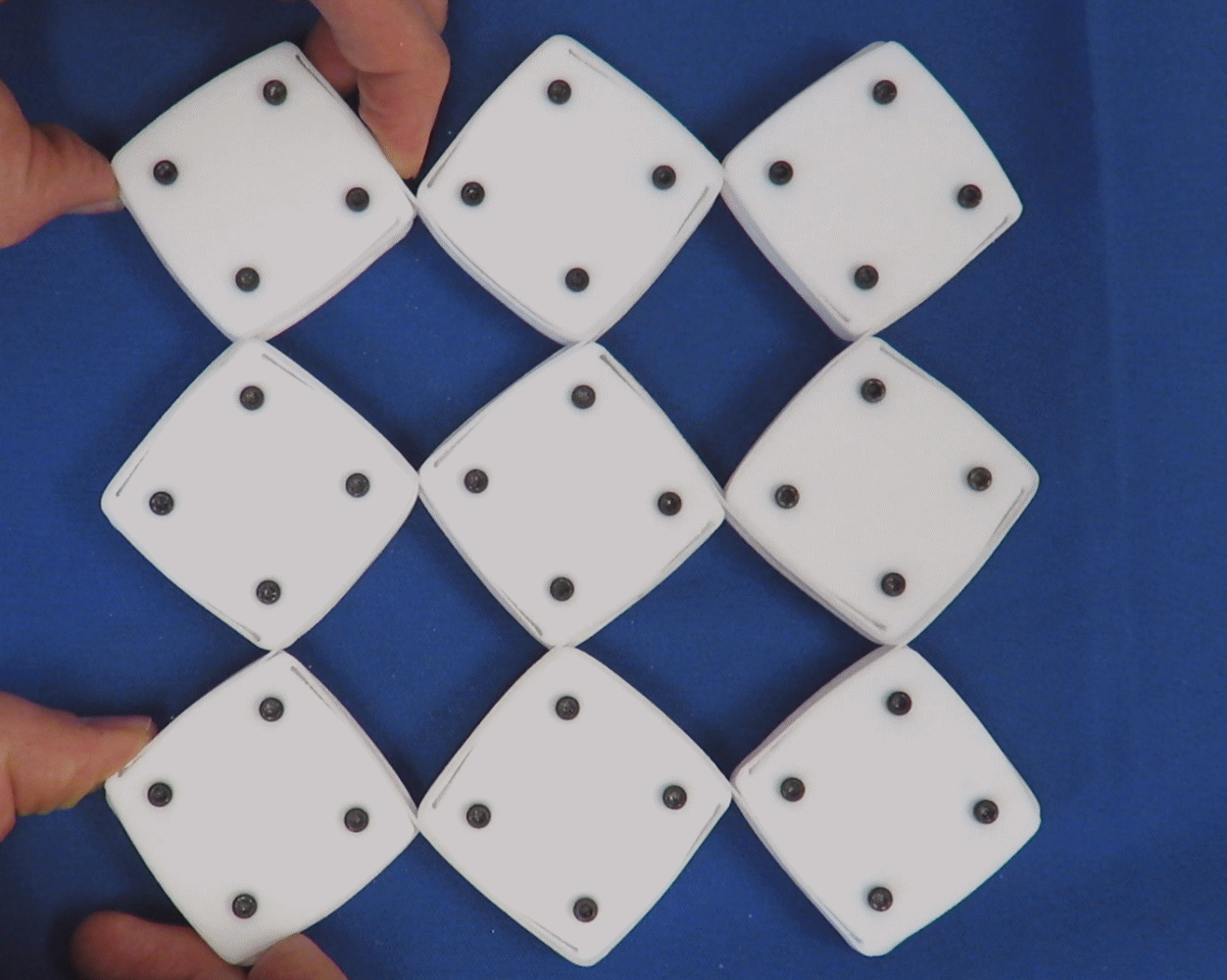
A compliant rolling-contact architected material (CRAM) with square-shaped cams that collectively achieve auxetic shape reconfigurability.
Engineering Micro-granular Crystals
The aim of this research is to enable the design and fabrication of crystals that consist of tightly packed microspheres of different materials and sizes within engineered lattices of various packing configurations. The ability to engineer such crystals is the key to controlling the propagation of stress waves throughout their lattice for enabling applications such as advanced armor, acoustic lenses, and sound scramblers. Such crystals could also be engineered with nano-sized spheres to achieve photonic crystal applications.

An ordered 3D micro-granular crystal consisting of different-material microspheres of different sizes.
Metamaterials that Achieve Tunable Thermal Expansion Coefficients
The aim of this research is to enable the synthesis of passive periodic metamaterials that can be made to achieve a large variety of positive, zero, or negative thermal expansion coefficients. This theory utilizes the principles of the Freedom, Actuation, and Constraint Topologies (FACT) synthesis approach in conjunction with Polytope Sector-based Synthesis (PSS) to enable designers to consider all the ways beam elements made of two different materials can be arranged within truss-like lattices to achieve desired thermally actuated properties. Click here to learn more.
Collaborators:
Chris Spadaccini
Lawrence Livermore National Laboratory
Professor Nick Fang
Massachusetts Institute of Technology

A passive periodic design that achieves a large negative thermal expansion coefficient.

An Ashby plot showing what property combinations an engineered lattice can achieve compared with those of natural materials. The boundary of the property combination region was generated using analytical tools.
Directionally Compliant Metamaterials (DCMs)
The aim of this research is to enable the design of a new kind of metamaterial that achieves desired anisotropic stiffness properties (i.e., the material is stiff in certain directions but is compliant along other desired directions with engineered degrees of freedom). Many of these materials require aperiodic unit cells that don't repeat within the material's microarchitecture. Thus, such materials required advanced computational tools to enable the rapid synthesis of their complex topologies. Click here to learn more.
Collaborators:
Carlos Galindo and Professor Julia Greer
California Institute of Technology
SEM video of an aperiodic DCM that achieves anisotropic stiffness properties (i.e., the lattice is stiff in all directions except about a screw axis).

Architected Materials that Achieve Tunable Poisson's Ratios
The aim of this research is to enable the synthesis and optimization of passive periodic architected materials that can be made to achieve a large variety of positive, zero, or negative Poisson's ratios. This theory utilizes a flexure-based transmission synthesis approach in conjunction with Polytope Sector-based Synthesis (PSS) to enable designers to arrange beam elements within a truss-like lattice to achieve the desired mechanical properties. Materials that maintain their negative Poisson behavior at high frequencies for dynamic or high-impact loading scenarios are of particular interest to our group. Click here to learn more.

A periodic lattice that passively achieves a large negative Poisson's ratio.
Multi-stable Shape-reconfigurable Architected Materials
The aim of this research is to enable the design of architected materials that utilize principles of multi-stability to achieve significant changes in net shape upon application of relatively small loads and to maintain those desired shapes after the loading is removed. This deformation is reversible and the original shape is recoverable by reversing the load direction. Click here to learn more.
Collaborators:
Babak Haghpanah and Professor Lorenzo Valdevit
University of California, Irvine

A 3D multi-stable architected material that can expand and contract in any direction.
Architected Materials with High Strength-to-weight Ratios
The aim of this research is to enable the synthesis and optimization of passive periodic architected materials that achieve high strength-to-weight ratios. The optimization approach utilizes nonlinear large-deformation analysis tools to accurately calculate when these materials fail due to yielding and buckling. Click here to learn more.

A variety of 3D printed lattices that achieve a high strength-to-weight ratio.
The aim of this research is to enable the synthesis and optimization of ductile micro-lattices that consist of beams surrounded by brittle filler material. These lattices achieve high strength and high stiffness properties for a variety of applications (e.g., armor). This approach combines the statistical theory of brittle failure with principles of linear elasticity to optimize the lattice's geometries. Click here to learn more.
Collaborators:
Chris Spadaccini and Eric Duoss
Lawrence Livermore National Laboratory

A fabricated 2D triangular ductile lattice made of aluminum surrounded by a brittle material made of Boron Carbide.
Architected Materials that Achieve Desired Mechanical Properties Over Large Ranges of Deformation
The aim of this research is to enable the synthesis and optimization of periodic architected materials that achieve a desired set of mechanical properties over finite-to-large amounts of deformation. Most architected materials are designed to exhibit desired instantaneous properties only. This research will allow designers to control how these properties change as the material is deformed beyond the linear regime (e.g., a designer could cause a material to increase or decrease in stiffness in a desired way as the material is deformed over a desired range). Click here to learn more.
Collaborators:
Arnoud Delissen and Professor Just Herder
Delft University of Technology

A fabricated 2D isotropic lattice that achieves a constant stiffness over a large range of deformation.
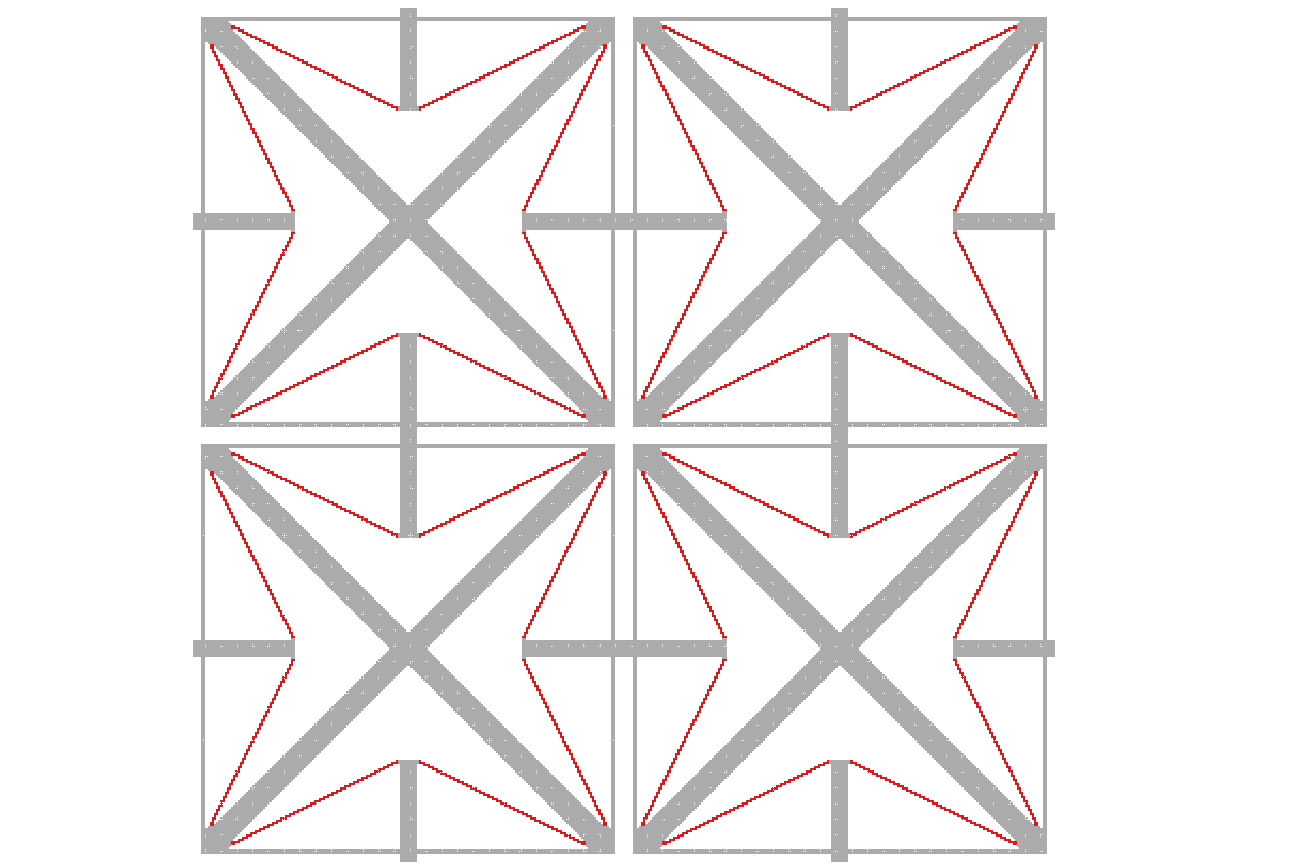
(A)

(B)
A negative Poisson ratio design inside a negative thermal expansion coefficient design (A) behaves differently than the same negative thermal expansion coefficient design inside the same negative Poisson ratio design (B).
Mechanical Logic-inspired Metamaterials
The aim of this research is to enable the design and fabrication of multi-stable flexure-based mechanical-logic gates that can be strung together within a lattice to achieve a new kind of metamaterial that can passively sense changes in ambient conditions or perform simple calculations without requiring power or emitting electromagnetic signatures and can do so in harsh environments that would otherwise destroy traditional electronic chips. Click here to learn more.
Collaborators:
Andy Pascal and Bob Panas
Lawrence Livermore National Laboratory
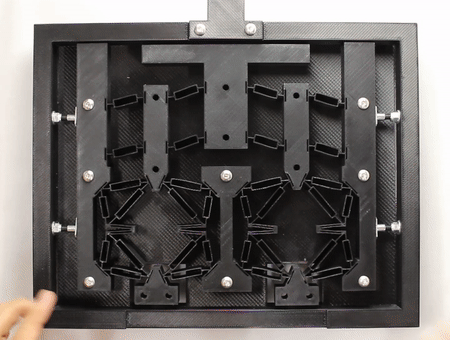
An example flexure-based NOR gate.
Fabricating Microstructures using Optical-tweezers Assembly
The aim of this research is to enable the rapid additive fabrication of 3D microarchitectures and nanostructures that consist of tiny particles of various shapes (e.g., spheres, wires, and flecks) and materials (e.g., metals, ceramics, and polymers), which are simultaneously and individually moved, positioned, and joined together using a multiplicity of coordianted optical traps (i.e., focused laser light that induces stable trapping forces on tiny objects). This approach will enable the fabrication of engineered micro-granular crystals. Click here to learn more.
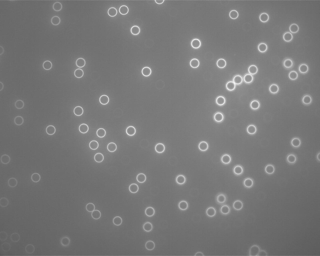
Microspheres being manipulated to form numbers 0 through 9 using an automated optical-tweezers algorithm

Continuous Flow Two-photon Lithography
The aim of this research is to create an additive approach that can rapidly produce large numbers of 3D arbitrarily shape micro-granular particles. Such particles could be organized and assembled to form microstructures using optical tweezers. The approach uses a scanned femtosecond laser to rapidly print the particles as they move in a constantly flowing photocurable medium in a micro-channel. Click here to learn more.

A continuous stream of 3D micro-gears being printed in real time using our approach.
Simultaneously Printing and Deforming Microstructures using Two-photon Stereolithography and Optical Tweezers
The aim of this research is to create a new integrated approach that can simultaneously (i) print microstructures using rapid two-photon stereolithography fabrication and (ii) deform those structures to actuate or store strain energy within their lattice using optical tweezers. Click here to learn more.
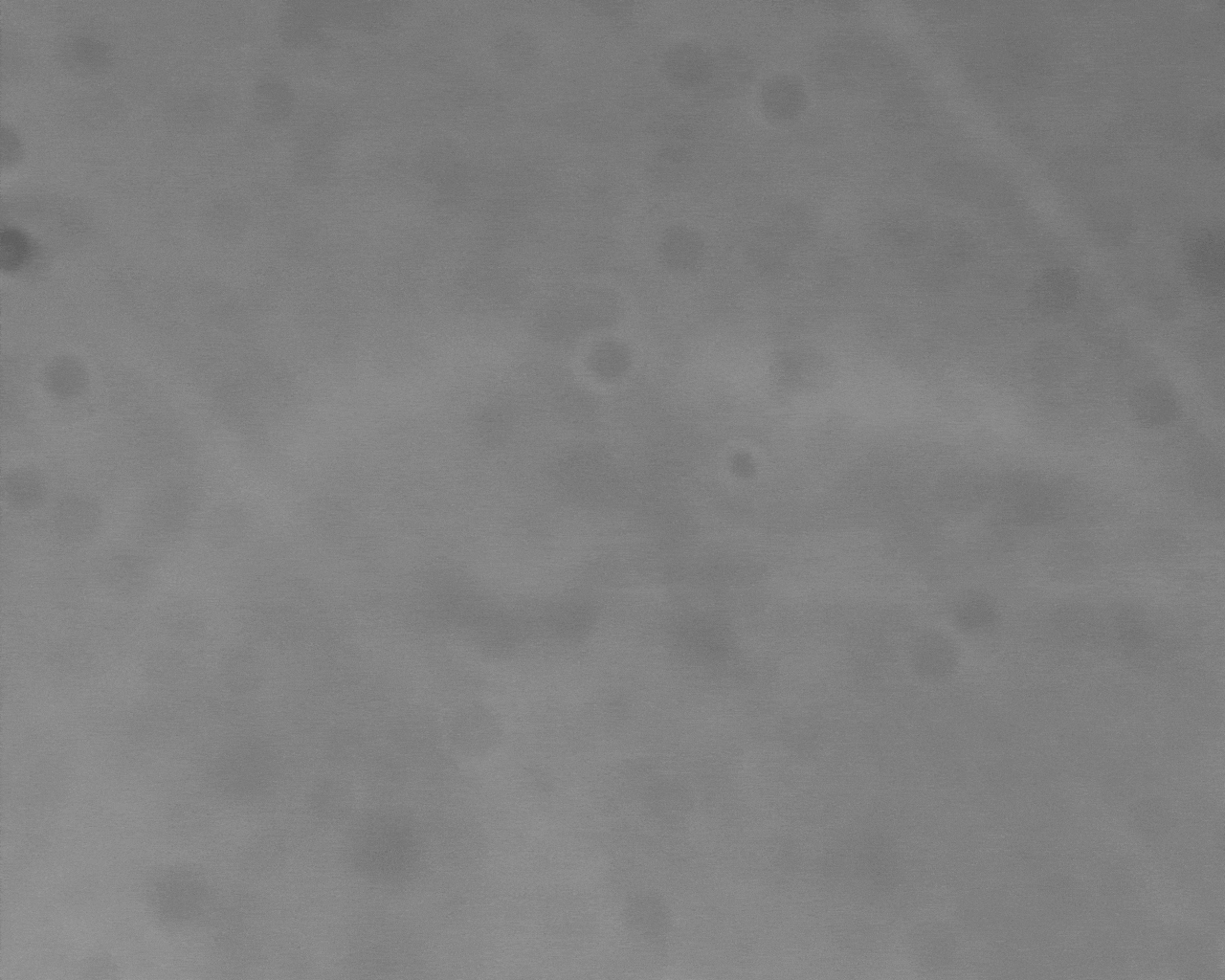
A 2D negative-Poisson's-ratio lattice that is fabricated using two-photon stereolithography and then actuated in real-time using optical tweezers.
Additive Fabrication via Multi-material Two-photon Stereolithography
The aim of this research is to create an advanced custom developed stereolithography system that can additively fabricate 3D microstructures with submicron-sized features made of different constituent materials using a two-photon laser to cure select regions of polymer within a liquid bath. Click here to learn more.

A 3x3x3 negative-Poisson's-ratio lattice fabricated using our custom developed two-photon system.
A High-speed Large-range Tip-tilt-piston Micromirror Array
Collaborators:
Bob Panas
Lawrence Livermore National Laboratory
Photograph of our fabricated micromirror-array design with only seven hexagonal mirrors.
Review of Published Micromirror Arrays Comparing their Performance Capabilities
The aim of this research is to review and categorize existing micromirror array designs within academia and industry according to how they are actuated and compare their performance capabilities using a variety of 2D and 3D performance plots similar to Ashby material-property plots. Performance parameters of interest include speed, range, fill factor, pitch, mirror size, number of degrees of freedom, and continuous verses digital (i.e., on-off) control. Theoretical performance limits are also calculated and plotted. Click here to learn more.
Collaborators:
Bob Panas
Lawrence Livermore National Laboratory
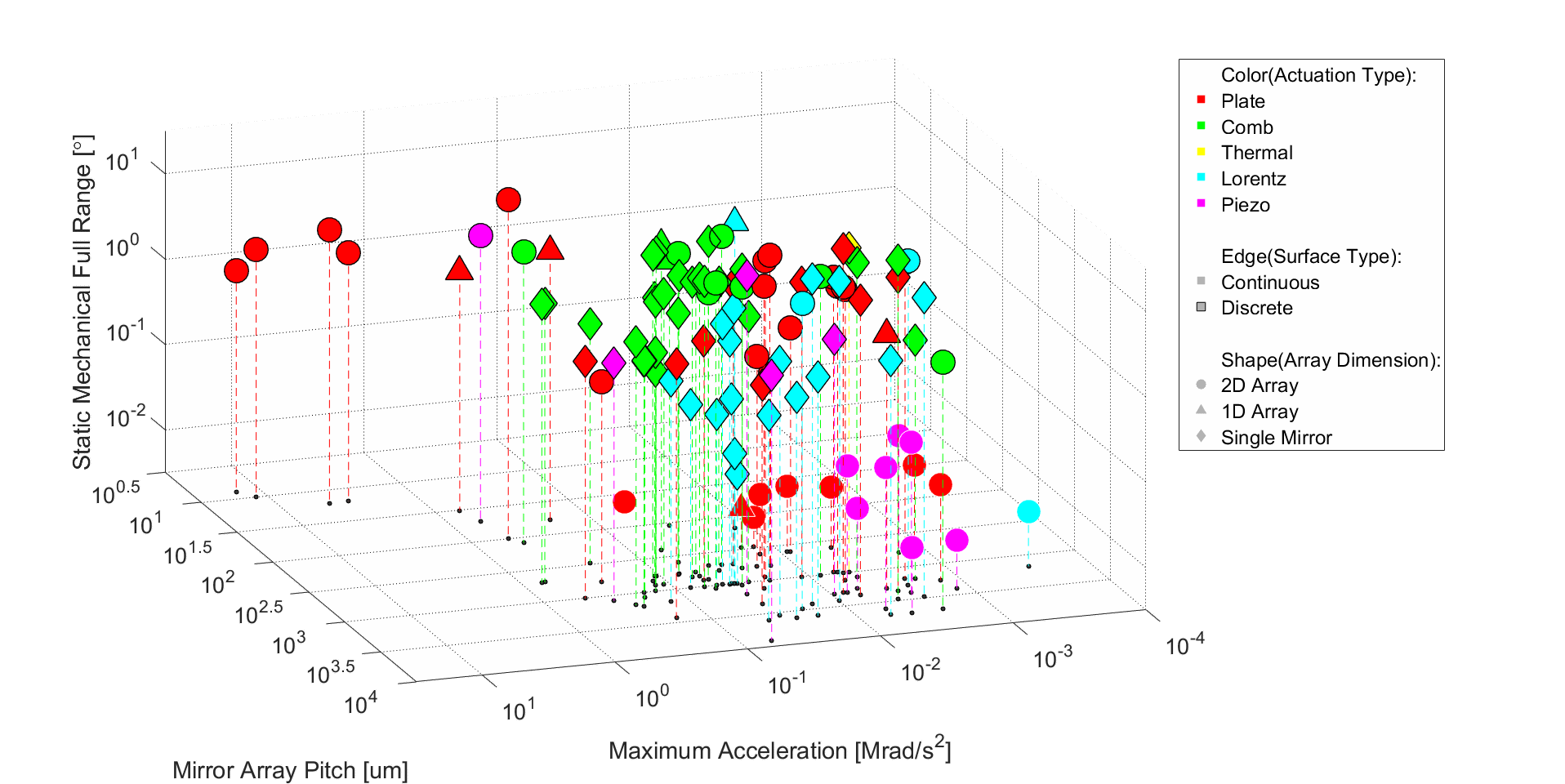
A 3D plot that compares the performance of published micromirrors.
Synthesis of Flexure Systems Using Freedom And Constraint Topologies (FACT)
The aim of this research is to enable designers to rapidly consider all the ways flexible elements (e.g., wire and blade flexures) can be arranged within a system consisting of rigid bodies joined together by these elements such that the system's stage achieves any desired set of degrees of freedom (DOFs). The approach for synthesizing the topologies of such flexure systems, called Freedom And Constraint Topologies (FACT), utilizes a comprehensive library of geometric shapes that guide designers in visualizing the regions of space within which designers can select the flexible elements that will constrain the system's stage such that it achieves the desired DOFs only. The systematic steps for synthesizing any parallel, serial, and hybrid flexure system using the geometric shapes of FACT have been created. Click here to learn more.

The FACT library of geometric shapes being used to synthesize a parallel system that constists of three wire flexures that join a stage with three intersecting rotational DOFs to a grounded body.

The FACT library of geometric shapes being used to synthesize the geometry of a circular hyperboloid flexible element.
Using Graph and Screw Theory to Analyze and Synthesize Interconnected Hybrid Flexure Systems
The aim of this research is to utilize graph and screw theory to enable software that can rapidly synthesize and analyze the kinematics of the most complex kind of hybrid flexure systems (i.e., interconnected hybrid systems). These systems possess at least one set of parallel limbs that are interconnected by flexure subsystems or elements that join the limbs’ intermediate bodies together. The traditional principles of the FACT approach can't be used to analyze or synthesize such interconnected hybrid systems because they can't be divided into parallel and serial subsystems entirely because their intermediate bodies are interconnected. Examples of such systems include flexure-based underconstraint-eliminator systems and microarchitectured material lattices. Click here to learn more.

Examples of interconnected hybrid flexure systems where 'S' is the system's stage, 'I' are the system's intermediate bodies, and 'G' is the system's grounded body. Note that some of the intermediate bodies are interconnected between the system's parallel limbs by flexible elements, which are shown as springs in the schematic.
Design of Transmission-based Flexure Systems
The aim of this research is to create the theory necessary to synthesize flexure systems that transform multiple desired input motions into other desired output motions with desired transmission ratios. This theory utilizes the geometric shapes of FACT to synthesize and arrange flexure subsystems that utilize screw motions to achieve the desired transmission ratios when they are assembled together. Analytical tools are also created to optimize the geometry of these transmission-based systems. Click here to learn more.
Collaborators:
Bob Panas
Lawrence Livermore National Laboratory

A transmission-based flexure system that transforms two rotational inputs, R1 and R2, imparted on two different bodies into two translational outputs, T1 and T2, on the system's stage with a desired transmission ratio of ~500 microns/degree.
Design of Flexure System's that Utilize Underconstraint-eliminator Linkages
The aim of this research is to create the theory necessary to synthesize flexure linkages that eliminate underconstraint in nested, large-stroke flexure systems. Typically such systems achieve their large ranges of motion (i.e., stroke) because they consist of nested modules that possess redundant degrees of freedom (DOFs). Unfortunately, however, these redundant DOFs result in underconstrained bodies that are susceptible to parasitic errors, unwanted vibrations, and poor controllability. The flexure linkages designed for this research eliminate underconstraint by coupling these bodies in a way that improves the system’s static and dynamic performance without increasing its size or decreasing its stroke. Click here to learn more.
Collaborators:
Bob Panas
Lawrence Livermore National Laboratory

A large-stroke planar translation flexure system that possesses an underconstraint-eliminator linkage to improve its static and dynamic performance.

A large-stroke planar three-DOF system with flexures that decouple the system's three micrometer actuators.

A tripod flexure system actuated by a micrometer that can be adjusted to drive the stage at different positions along its post.
Designing and Simulating the Behavior of Single-atom-thin Flexures
The aim of this research is to design and simulate the behavior of flexures that consist of a single layer of atoms (e.g., graphene membranes). Applications of interest include nano-scale resonators, switches, and electrostatic discharge devices. The behavior of such flexures is modeled using molecular dynamic simulators. Click here to learn more.
Collaborators:
Jimmy Ng and Professor Ya-Hong Xie
University of California, Los Angeles

Simulation of a graphene membrane flexure electrostatically actuated toward a charged layer.
Soft Robots that Consist of Tri-chamber Actuators
The aim of this research is to introduce a new type of spatial parallel robot that is comprised of soft inflatable constraints called Tri-chamber Actuators (TCAs). These cylindrical actuators are made of a soft material with three axisymmetric channels along their axis that can be inflated with air to deform them in controlled ways. The concepts of passive and active freedom spaces are introduced and applied to the design of general parallel systems that consist of active constraints (i.e., constraint that can be actuated to impart various loads onto the system’s stage) that both drive desired motions and guide the system’s desired degrees of freedom (DOFs). Click here to learn more.
Collaborators:
Professor Charles Kim
Bucknell University

A six-axis soft robot that is actuated pneumatically by Tri-chamber Actuators.
Soft Robots with Active Components Embedded within Molded PDMS Structures
The aim of this research is to design and fabricate soft robots by placing actuators and sensors within 3D printed molds that are then filled with liquid polymers (e.g., PDMS) that harden as they cure. Our group has fabricated actively controlled metamaterials, peristaltic pumps, and soft actuators using this approach. Click here to learn more.

An actively controlled soft metamaterial made using the proposed approach.
Design of a Compliant Port for Minimally Invasive Heart Surgery
The aim of this research is to introduce a new surgical port that enables the introduction of surgical instruments into chambers of the beating heart during minimally invasive, intracardial surgical procedures without allowing the introduction of micro-emboli 0.1 mm or larger in size. The design consists of an outer port body that is secured to the heart wall using a purse string suture and a series of inner tubular sleeves that form the interface between the port and the transecting instrument. The design enables rapid tool changes and accommodates a wide variety of instruments. The port uses a fluid purging system to dislodge and remove emboli from the surgical instrument. Click here to learn more.
Collaborators:
Professor Alex Slocum
Massachusetts Institute of Technology

A compliant tri-leaflet end seal that allows endoscopic tools to pass in and out of a heart port.
The aim of this research is to introduce a low-cost hand-held instrument that may be used to characterize the mechanical compliance of the surface layer of skin on a human finger tip. Mechanical compliance is a measure of how much a structure resists motion when subjected to a given force. It relates forces with velocities acting on a mechanical system. The ability to directly measure the compliance of skin is important for diagnosing patient conditions. This ability finds applications in medical devices for assessing whether a patient is dehydrated, has diabetes, or possesses other skin diseases. Furthermore, robotic manipulator optimization requires mimicking the compliance of human fingers during gripping, catching, and holding. Analyzing the compliance of human finger tips under these conditions would help improve robotic grippers and manipulators. Click here to learn more.
Collaborators:
Bob Panas
Lawrence Livermore National Laboratory

A flexure-based device that rapidly measures the dynamic compliance of skin.










